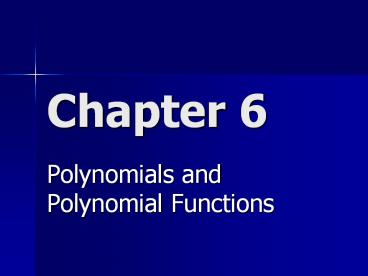Polynomials and Polynomial Functions - PowerPoint PPT Presentation
1 / 29
Title: Polynomials and Polynomial Functions
1
Chapter 6
- Polynomials and Polynomial Functions
2
Instructions for this PowerPoint.
- If there is a linked word(s), then click on them.
- If there is an arrow in the lower corner, then
follow it after you have used all links. - If there are no links or arrows then just click
to proceed to the next slide.
3
Polynomial Functions
- Exploring Polynomial Functions
- Examples
- Modeling Data with Polynomial Functions
- Examples
4
Degree Name of Degree Number of Terms Name using number of terms
0 Constant 1 Monomial
1 Linear 2 Binomial
2 Quadratic 3 Trinomial
3 Cubic 4 3rd degree Polynomial
4 Quartic n 4th degree Polynomial with n terms
5 Quintic 5th degree polynomial with n terms
5
x 0 3 5 6 9 11 12 14
y 42 31 26 21 17 15 19 22
6
(No Transcript)
7
Polynomials and Linear Factors
- Standard Form
- Example
- Factored Form
- Examples
- Factors and Zeros
- Examples
8
Writing a polynomial in standard form
You must multiply
(x 1)(x2)(x3)
X3 6x2 11x 6
9
2x3 10x2 12x
2x(x2 5x 6)
10
Factor Theorem
The expression x-a is a linear factor of a
polynomial if and only if the value a is a zero
of the related polynomial function.
11
Factors and Zeros
ZEROS
FACTORS
- -3
- -2
- -1
- 0
- 1
- 2
- 3
- (x (-3)) or (x 3)
- (x (-2)) or (x 2)
- (x (-1)) or (x 1)
- (x 0) or x
- (x 1)
- (x 2)
- (x 3)
12
Dividing Polynomials
- Long Division
- Synthetic Division
13
Long Division
- The purpose of this type of division is to use
one factor to find another.
)
4
40
x - 1
x3 6x2 -6x - 1
Just as 4 finds the 10
The (x-1) finds the (x2 7x 1)
14
Synthetic Division
- When dividing by x a, use synthetic division.
- The Remainder Theorem
15
The Remainder Theorem
- When using Synthetic Division, the remainder is
the value of f(a). - This method is as good as PLUGGING IN, but may
be faster.
16
Solving Polynomial Equations
- Solving by Graphing
- Solving by Factoring
17
Solving by Graphing
- Set equation equal to 0, then substitute y for 0.
Look at the x-intercepts. (Zeros) - Let the left side be y1and let the right side be
y2. (Very much like solving a system of
equations by graphing). Look at the points of
intersection.
18
Solving by Factoring
- Sum of two cubes
- (a3 b3) (a b)(a2 ab b2)
- Difference of two cubes
- (a3 b3) (a b)(a2 ab b2)
19
More on Factoring
- If a polynomial can be factored into linear or
quadratic factors, then it can be solved using
techniques learned from earlier chapters. - Solving a polynomial of degrees higher than 2 can
be achieved by factoring.
20
Theorems about Roots
- Rational Root Theorem
- Irrational Root Theorem
- Imaginary Root Theorem
21
Rational Root Theorem
- What are Rational Roots?
- Ps and Qs . )
- Using the calculator to speed up the process.
22
And the Rational Roots are..
P includes all of the factors of the constant.
Q includes all of the factors of the leading
coefficient.
f(x) x3 13x - 12
The possible rational roots are
p 12 q 1
23
Test the Possible Roots
In this case all roots are real and rational,
but you need only to find one rational root.
This will become clear later.
24
Since -1, -3, and 4 are the Roots, (x 1), (x
3), and (x 4) are the factors.
Multiply to show that
(x1)(x3)(x-4) x3 13x 12
(x1)(x2 x 12) x3 x2 12x
x2 x 12 x3 13x 12
25
Irrational Root Theorem
These are called CONJUGATES.
26
Imaginary Root Theorem
These are called CONJUGATES.
27
The Fundamental Theorem of Algebra
- If P(x) is a polynomial of degree
with complex coefficients, then P(x) 0 has
at least one complex root. - A polynomial equation with degree n will have
exactly n roots the related polynomial function
will have exactly n zeros.
28
The Binomial Theorem
- Binomial Expansion and Pascals Triangle
- The Binomial Theorem
29
PASCALS TRIANGLE
1 1 1 1 2 1 1 3 3 1 1
4 6 4 1 1 5 10 10 5
1 1 6 15 20 15 6 1 1 7
21 35 35 21 7 1 1 8 28
56 70 56 28 8 1 1 9 36
84 126 126 84 36 9 1































